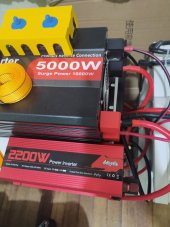Hi everyone. I'm a newbie who currently has a EG4 6000ex and a set of 48V LifePower batteries coming from SS. While waiting, I made the mistake of looking on craigslist and seeing some Victron equipment for sale at a big discount from a guy parting out his RV system. Now I have a MultiPlus-II 48/3000/35-50 120V, Lynx Distributor, and SmartShunt sitting in the garage waiting to be used.
My initial intent was to create a small off grid system at my home that was capable of L2 charging an EV and/or running an A/C unit like in one of Will Prowse's videos. However, after seeing one of Will's latest video with the 6000ex, I'm realizing that high idle consumption of the unit wouldn't make it the ideal choice for low consumption loads when not running the EV charger or A/C.
My questions to you all: Is it possible to use both the 6000ex (to run 240V loads) and Multiplus (for smaller loads) on the same battery bank without ruining either inverter? Can I connect them both on the same subpanel while only using one inverter at a time? Or...since I'd will be using the solar controller function of the 6000ex, could I piggyback it to the Multiplus by connecting the 6000ex AC output to the Multiplus AC input? Are there any options? Thank you. I'll appreciate any input.
My initial intent was to create a small off grid system at my home that was capable of L2 charging an EV and/or running an A/C unit like in one of Will Prowse's videos. However, after seeing one of Will's latest video with the 6000ex, I'm realizing that high idle consumption of the unit wouldn't make it the ideal choice for low consumption loads when not running the EV charger or A/C.
My questions to you all: Is it possible to use both the 6000ex (to run 240V loads) and Multiplus (for smaller loads) on the same battery bank without ruining either inverter? Can I connect them both on the same subpanel while only using one inverter at a time? Or...since I'd will be using the solar controller function of the 6000ex, could I piggyback it to the Multiplus by connecting the 6000ex AC output to the Multiplus AC input? Are there any options? Thank you. I'll appreciate any input.



